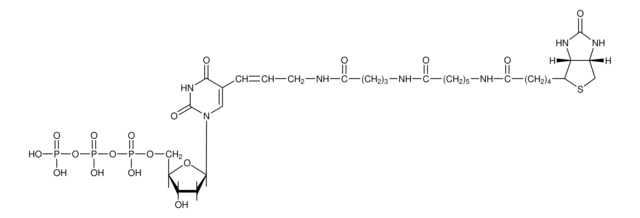Wszystkie zdjęcia(1)
Kluczowe dokumenty
11373242910
Roche
Fluorescein-12-dUTP
≥85% (HPLC), suitable for ELISA, suitable for hybridization, solution
Synonim(y):
Fluorescein-12-dUTP, dUTP
Zaloguj sięWyświetlanie cen organizacyjnych i kontraktowych
About This Item
Kod UNSPSC:
41116100
Polecane produkty
Poziom jakości
Próba
≥85% (HPLC)
Postać
solution
masa cząsteczkowa
Mr 1018.4 (fluorescein-12-dUTP-Li4)
opakowanie
pkg of 25 μL (25 nmol; 1mM)
producent / nazwa handlowa
Roche
metody
ELISA: suitable
hybridization: suitable
temp. przechowywania
−20°C
Zastosowanie
Fluorescein-12-dUTP is used as a substrate for:
- terminal transferase
- DNA polymerase I (holoenzyme and Klenow fragment),
- Taq DNA polymerase
- reverse transcriptase (e.g., from AMV and M-MuLV).
Jakość
Typical analysis: At least 85% Fluorescein-12-dUTP (HPLC, area%).
Postać fizyczna
Fluorescein-12-dUTP, tetralithium salt.
Przechowywanie i stabilność
The unopened reagent is stable at 15 to 25°C until the expiration date printed on the label. Decomposition of approx. 5% may occur within 6 months.
Inne uwagi
For life science research only. Not for use in diagnostic procedures.
Ta strona może zawierać tekst przetłumaczony maszynowo.
Kod klasy składowania
12 - Non Combustible Liquids
Klasa zagrożenia wodnego (WGK)
nwg
Temperatura zapłonu (°F)
does not flash
Temperatura zapłonu (°C)
does not flash
Certyfikaty analizy (CoA)
Poszukaj Certyfikaty analizy (CoA), wpisując numer partii/serii produktów. Numery serii i partii można znaleźć na etykiecie produktu po słowach „seria” lub „partia”.
Masz już ten produkt?
Dokumenty związane z niedawno zakupionymi produktami zostały zamieszczone w Bibliotece dokumentów.
Klienci oglądali również te produkty
Nucleoporin 107, 62 and 153 mediate Kcnq1ot1
imprinted domain regulation in extraembryonic
endoderm stem cells
imprinted domain regulation in extraembryonic
endoderm stem cells
Sachani SS, et al.
Nature Communications (2018)
Pro-survival redox signalling in progesterone-mediated retinal
neuroprotection
neuroprotection
Lopez R, et al.
The European Journal of Neuroscience, 46(1) (2017)
Shang-mian Yie et al.
Human reproduction (Oxford, England), 21(10), 2538-2544 (2006-05-11)
We have previously demonstrated that progesterone has a stimulatory effect on HLA-G gene expression. Because this effect was abolished by the anti-progestin, RU486, we hypothesize that this effect is through receptor-mediated up-regulation of the HLA-G gene. The objective of this
Nasz zespół naukowców ma doświadczenie we wszystkich obszarach badań, w tym w naukach przyrodniczych, materiałoznawstwie, syntezie chemicznej, chromatografii, analityce i wielu innych dziedzinach.
Skontaktuj się z zespołem ds. pomocy technicznej



